Tethered Aerostats
Tethered aerostats are unmanned non-rigid lighter-than-air vehicles (a.k.a. blimps), which remain anchored to the ground by one or more ropes. They are used for various surveillance tasks, where a low-cost long-endurance (up to a month) stationary aerial platform is needed. In all tethered aerostat systems, the main tether not only holds the blimp in position, but also provides electrical power to the vehicle's systems as well as a data link (via fiber optics in all modern systems) to communicate with the on-board sensors. The main envelope of an aerostat is filled with helium, while the stablizing tail fins are normally filled with air. The payload is located in a ventral dome under the envelope. The aerodynamic shape of the envelope and the tail fins provide a stable platform in the presence of modest winds and gusts. However, for each aerostat system there is a maximum wind speed in which it can safely operate. Loss of blimps to suddenly deteriorating weather conditions can be a problem for operators of tethered aerostat systems. When moored to the ground, large aerostats are anchored to a rotating mast so that they can freely weathervane in the wind.
TARS (Tethered Aerostat Radar System)
The U.S. Air Force's TARS (Tethered Aerostat Radar System) has its origins in the early 1980s. In December 1980 the USAF began to use a tethered aerostat (with 250000 ft3 volume) at Cudjoe Key, FL, for surveillance purposes. Beginning in 1984, the U.S. Customs Service began to build up a network of aerostat sites on the southern U.S. border to detect illegal drug trafficking. The Coast Guard also operated tethered aerostat systems along the Gulf of Mexico. For more efficient operation of all aerostat sites, Congress mandated in 1992 that the program was to be managed as a whole by the Department of Defense. DOD in turn designated the Air Force as the executive agency for the border surveillance aerostats. A total of 11 sites were operated at one time, but as of 2003 only eight were still operational. Primary task of the system still is low-level air surveillance, helping other federal agencies to detect and intercept drug traffic.
Initially, the TARS sites used aerostat envelopes built by General Electric, but these had severe reliability problems. Because of excessive helium leakage, the blimps repeatedly failed to maintain altitude for the expected duration. As a result, the blimps were replaced in the early 1990s by TCOM 71M LASS (Low-Altitude Surveillance System) blimps with an AN/TPS-63 surveillance radar.
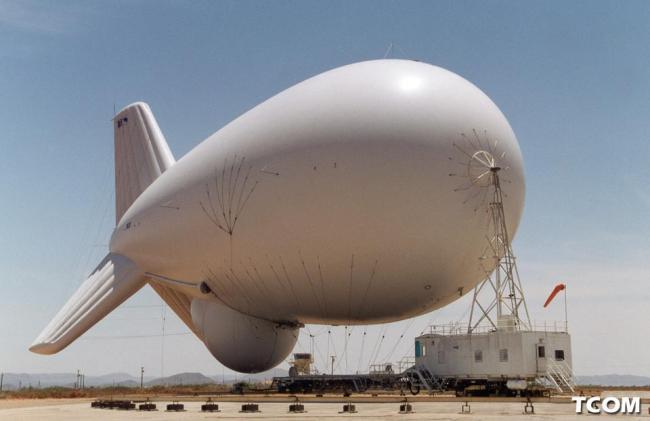 |
| Photo: TCOM |
| 71M |
Beginning in the late 1990s, the aerostat sites were equipped with Lockheed Martin 420K aerostats. This blimp carries the Lockheed Martin L-88 as its primary payload, a surveillance radar with a range of 370 km (200 nm). The 420K's envelope shape, fin design, and cable attachment points are further optimized for high aerodynamic stability and easy ground handling. While Lockheed Martin is the prime contractor for the 420K aerostats, the envelopes are built by ILC Dover.
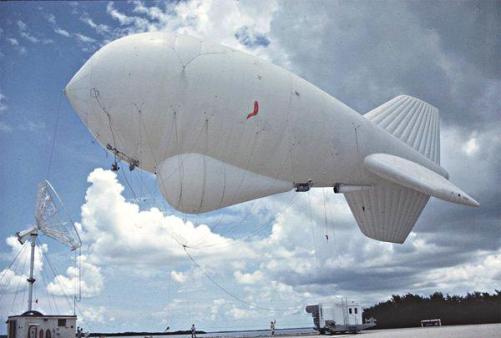 |
| Photo: Lockheed Martin |
| 420K |
As of 2004, all TARS sites except one were equipped with the 420K aerostats. The exception is Cudjoe Key, which uses two smaller, but otherwise similar, Lockheed Martin 275K blimps. One carries the L-88(V)3, a light-weight L-88 derivative, while the other is used to transmit the "TV Marti" TV program into Cuba.
JLENS (Joint Land Attack Cruise Missile Defense Elevated Netted Sensor)
The JLENS program was begun in 1996 to develop an aerostat-based surveillance system to protect U.S. land forces from attacks by cruise missiles. The concept studies were finished in August 1997, and following an official request for proposals, Raytheon received the first JLENS development contract in January 1998.
Each JLENS system consists of two TCOM 71M aerostats, one containing a surveillance radar (SuR) and the other a so-called precision track illumination radar (PTIR). Following initial threat detection by the SuR, the PTIR takes over to generate a fire solution for any available surface-to-air missiles. The system is designed to be mobile for deployment to any theater of operations. JLENS prototype systems have been demonstrated during various exercises since 1999, and the U.S. military is currently planning to acquire 12 operational systems.
 |
| Photo: TCOM |
| 71M |
RAID (Rapid Aerostat Initial Deployment)
For Operation Enduring Freedom in 2001, the U.S. Army deployed three small TCOM 15M aerostat systems to Afghanistan under the RAID program. The RAID systems were essentially a much smaller version of JLENS, and provided short-range (several kilometers) area surveillance and early warning against attacks with small arms, rockets and mortars.
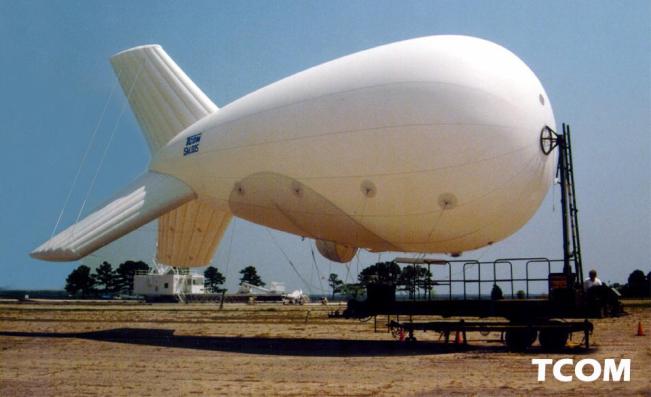 |
| Photo: TCOM |
| 15M |
REAP (Rapidly Elevated Aerostat Platform)
REAP is a small aerostat system, which was developed by the ONR (Office of Naval Research) and the Army Material Command. Two REAP systems deployed to the U.S. Army in Iraq in December 2003.
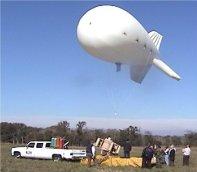 |
| Photo: Bosch Aerospace |
| REAP |
The REAP aerostat, built by ISL's Bosch Aerospace Division, is specifically designed for quick deployment. The whole system, including the deflated blimp, is transported in a container on top of a vehicle (HMMWV in the Army application). After attaching the payload to the tether line, an automatic sequence can be started, which inflates the aerostat and releases the tether until a preselected altitude has been reached. The whole procedure takes only around five minutes. The Army's standard REAP payload consists of electro-optical (day time) and night vision cameras, which have an effective surveillance radius of about 33 km (18 nm) at the blimp's operating altitude of 90 m (300 ft).
PTDS (Persistent Threat Detection System)
In June 2004, Lockheed Martin delivered the first of two 56K aerostat surveillance systems to the U.S. Army for use in Iraq. They were equipped with EO/IR (Electro-Optical/Infrared) cameras, and used for the defense of ground forces and high-value assets around Baghdad. The Lockheed Martin 56K is a smaller version of the 275K and 420K aerostats used in the TARS systems (q.v.). It can carry a payload of 225 kg (500 lb) to 760 m (2500 ft).
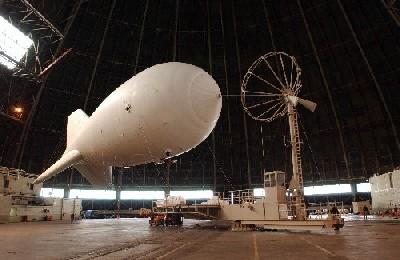 |
| Photo: Lockheed Martin |
| 56K |
MARTS (Marine Airborne Re-Transmission System)
During operations in Iraq, the U.S. Marine Corps issued an urgent requirement for a low-cost secure and reliable non-line-of-sight VHF/UHF radio communications relay. DARPA in turn developed the Marine Airborne Re-Transmission System based on a TCOM 32M tethered aerostat.
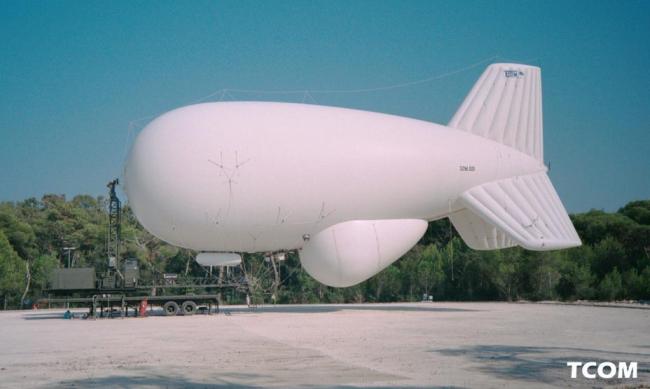 |
| Photo: TCOM |
| 32M |
The MARTS aerostat is equipped with transponders for AN/PRC-113, AN/PRC-117, AN/PRC-119 (SINCGARS) and EPLRS (Enhanced Position Locating and Reporting System) radios, and provides a 24/7 relay with a radius of 125 km (80 miles) for up to 15 days (when the helium supply has to be refilled). The blimp is designed to survive winds up to 85 km/h (50 knots), lightning strikes, and small arms fire from the ground. The first MARTS system was moved to Iraq in early 2005, and current plans call for the acquistion of a total of six systems.
Specifications
Note: Data given by several sources show slight variations. Figures given below may therefore be inaccurate!
Data for 56K, 275K, 420K, 15M, 32M, 71M and REAP aerostats:
| 56K (PTDS) | 275K (TARS) | 420K (TARS) | |
|---|---|---|---|
| Length | 33.4 m (109.5 ft) | 57 m (187 ft) | 63.5 m (208.5 ft) |
| Diameter | 11.1 m (36.5 ft) | 19 m (62.5 ft) | 21.2 m (69.5 ft) |
| Volume | 1600 m3 (56000 ft3) | 7800 m3 (275000 ft3) | 12000 m3 (420000 ft3) |
| Payload | 225 kg (500 lb) | 450 kg (1000 lb) | 900 kg (2000 lb) |
| Ceiling | 760 m (2500 ft) | 3700 m (12000 ft) | 4600 m (15000 ft) |
| Endurance | ? | 10 days | 30 days |
| 15M (RAID) | 32M (MARTS) | 71M (TARS, JLENS) | REAP | |
|---|---|---|---|---|
| Length | 15 m (49 ft) | 32 m (105 ft) | 71 m (233 ft) | 9.5 m (31 ft) |
| Volume | 290 m3 (10200 ft3) | 1800 m3 (63000 ft3) | 16700 m3 (590000 ft3) | 74 m3 (2600 ft3) |
| Payload | 90 kg (200 lb) | 225 kg (500 lb) | 2300 kg (5000 lb) | 16 kg (35 lb) |
| Ceiling | 300 m (1000 ft) | 900 m (3000 ft) | 4600 m (15000 ft) | 90 m (300 ft) |
| Endurance | 5-7 days | 15 days | 30 days | 10 days |
Main Sources
[1] Kenneth Munson (ed.): "Jane's Unmanned Aerial Vehicles and Targets, Issue 15", Jane's, 2000
[2] "Unmanned Aircraft Systems Roadmap, 2005-2030", Office of the Secretary of Defense, August 2005
[3] FAS Website
[4] TCOM Website
[5] Bosch Aerospace Website
Back to Directory of U.S. Military Rockets and Missiles, Appendix 4
Last Updated: 13 September 2005